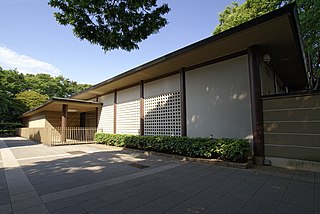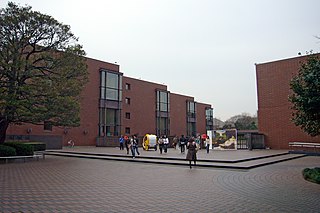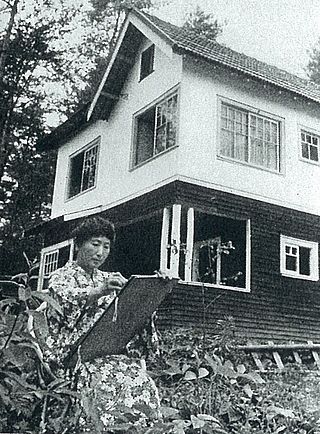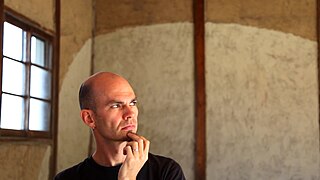Related Research Articles

Tokyo University of the Arts or Tokyogeidai (東京芸大) is a school of art and music in Japan. Located in Ueno Park, it also has facilities in Toride, Ibaraki, Yokohama, Kanagawa, Kitasenju and Adachi, Tokyo. The university has trained renowned artists in the fields of painting, sculpture, crafts, inter-media, sound, music composition, traditional instruments, art curation and global arts.

Toko Shinoda was a Japanese artist. Shinoda is best known for her abstract sumi ink paintings and prints. Shinoda's oeuvre was predominantly executed using the traditional means and media of East Asian calligraphy, but her resulting abstract ink paintings and prints express a nuanced visual affinity with the bold black brushstrokes of mid-century abstract expressionism. In the postwar New York art world, Shinoda's works were exhibited at the prominent art galleries including the Bertha Schaefer Gallery and the Betty Parsons Gallery. Shinoda remained active all her life and in 2013, she was honored with a touring retrospective exhibition at four venues in Gifu Prefecture to celebrate her 100th birthday. Shinoda has had solo exhibitions at the Seibu Museum at Art, Tokyo in 1989, the Museum of Fine Arts, Gifu in 1992, the Singapore Art Museum in 1996, the Hara Museum of Contemporary Art in 2003, the Sogo Museum of Art in 2021, the Tokyo Opera City Art Gallery in 2022, and among many others. Shinoda's works are in the collection of the Albright-Knox Art Gallery, the Art Institute of Chicago, the British Museum, the Brooklyn Museum, the Harvard Art Museums, the Metropolitan Museum of Art, the Museum of Fine Arts, Boston, the National Museum of Modern Art, Tokyo, the Singapore Art Museum, the Smithsonian Institution, the Solomon R. Guggenheim Museum, the National Gallery of Victoria, and other leading museums of the world. Shinoda was also a prolific writer published more than 20 books.

Japan Art Academy is the highest-ranking official artistic organization in Japan. It is established as an extraordinary organ of the Japanese Agency for Cultural Affairs in the thirty-first article of the law establishing the Ministry of Education, Culture, Sports, Science and Technology. The Academy discusses art-related issues, advises the Minister of Education, Culture, Sports, Science and Technology on art-related issues, and promotes arts in three categories: 1) fine art, 2) literary arts, 3) music, drama, and dance. It is closely associated with the annual Japan Art Academy Exhibition (Nitten), the premier art exhibition in Japan; the Japan Art Academy originally ran the Nitten but since 1958 the exhibition is run by a separate private institution. The Japan Art Academy headquarters is in Ueno Park, Tokyo.

The National Museum of Modern Art, Tokyo, also known as MOMAT, is the foremost museum collecting and exhibiting modern Japanese art. The museum, in Chiyoda, Tokyo, Japan, is known for its collection of 20th-century art and includes Western-style and Nihonga artists. It has a branch, the National Crafts Museum, in the city of Kanazawa.
Ei-Q was a Japanese artist who worked in a variety of media, including photography and engraving.

The Tokyo Metropolitan Art Museum is a museum of art located in Ueno Park, Tokyo, Japan. It is one of Japan's many museums which are supported by a prefectural government. The first public art museum in Japan, it opened in 1926 as the Tokyo Prefectural Art Museum and was renamed in 1943 after Tokyo became a metropolitan prefecture. The museum's current building was constructed in 1975 and designed by modernist architect Kunio Maekawa, remaining one his most well-known works today.
Minoru Kawabata was a Japanese artist. Kawabata is best known for his color field paintings. Between 1960 and 1981, Kawabata had 11 solo shows at the prominent Betty Parsons Gallery in New York. At the 31st Venice Biennale in 1962, Kawabata’s work was exhibited in the Japan Pavilion alongside that of four other Japanese artists. Kawabata has had solo exhibitions at the Everson Museum of Art in 1974, the Museum of Modern Art, Kamakura in 1975, the National Museum of Modern Art, Kyoto and Ohara Museum of Art in 1992, and Yokosuka Museum of Art in 2011. Kawabata’s works are in the collection of the Albright-Knox Art Gallery, Artizon Museum, Everson Museum of Art, Museum of Contemporary Art Tokyo, the Museum of Modern Art, Kamakura & Hayama, the Museum of Modern Art, São Paulo, the National Museum of Art, Osaka, the National Museum of Modern Art, Kyoto, the National Museum of Modern Art, Tokyo, the Newark Museum of Art, Ohara Museum of Art, Solomon R. Guggenheim Museum, Yokohama Museum of Art, Yokosuka Museum of Art, among others.
Shigeru Nakanishi is a Japanese artist from Tokyo, Japan.

Keiko Minami was a Japanese artist, aquatint engraver, and poet. She is best known for her pictograph-like aquatints with a whimsical, childlike aesthetic.
Madokoro Akutagawa Saori was a Japanese painter whose works were often associated with primitivism, folkloric and mythological subjects, as well as unique dyeing techniques. Her paintings from the 1950s manifest various themes from distorted and dramatic portrayal of women to divine narratives based on traditional Japanese folklore. After briefly studying and living in the US, Akutagawa shifted her artistic exploration towards abstraction before her death at a young age in 1966.

Migishi Setsuko was a Japanese yōga (Western-style) painter. Known for employing vivid colors and bold strokes for still-life and landscape, Migishi contributed greatly to the establishment and elevation of the status of female artists in the Japanese art scene.

James Jack is a contemporary artist based in Japan.

The Sezon Museum of Modern Art is an art museum located in Karuizawa, Nagano Prefecture, Japan. The museum hosts exhibitions on contemporary art.
Kyun-Chome (キュンチョメ) is a Japanese artist unit based in Tokyo, made up of Nabuchi and Honma Eri. They emerged as an art unit after the 2011 Great East Japan Earthquake, and rose to prominence after winning the 17th Taro Okamoto Art Award in 2014.
Nobuyuki Ōura is a Japanese artist and filmmaker. Ōura has also been referred to in English as Ohura Nobuyuki. He has been described as an artist who "constantly pushes the limits of expression," as his artworks and films delve into taboos within Japanese society. Ōura is best known for his controversial series of lithographs entitled Holding Perspective (1982–85), which include photographs Emperor Hirohito and have at been at the center of multiple high-profile incidences of censorship in Japan since the mid-1980s.
Hideko Fukushima, born Aiko Fukushima, was a Japanese avant-garde painter born in the Nogizaka neighborhood of Tokyo. She was known as both a founding member of the Tokyo-based postwar avant-garde artist collective Jikken Kōbō and was recruited into Art Informel circles by the critic Michel Tapié during his 1957 trip to Japan. As a member of Jikken Kōbō she participated in art exhibitions, designed visuals for slide shows and costumes and set pieces for dances, theatrical performances, and recitals. She contributed to the postwar push that challenged both the boundaries between media and the nature of artistic collaboration, culminating in the intermedia experiments of Expo '70.
Tamiji Kitagawa was a Japanese painter, printmaker and art educator.
Futoshi Miyagi is an Okinawan artist and writer. He works in various mediums, such as photography, objects, video and text, to construct narratives on the subjects of sexual minorities and untold stories in history, often in relation to Okinawa. Much of Miyagi's earlier work is inspired by his own memories and coming to terms with his identity as a gay Okinawan man. Over the course of his career, Miyagi has increasingly expanded the range of his subjects to include imagined characters and historical figures. Miyagi is most known for his American Boyfriend Series, an ongoing project that addresses the topic of queer relationships through narrative form. The series, a culmination of Miyagi's multidisciplinary approach, consists of a blog, numerous video works, and a novel, and mimics the evolution of his oeuvre from semi-autobiographical to historically based fiction. Miyagi takes influences from a wide range of arts and media, including the work of feminist writers and artists Lucy Lippard and Mierle Laderman Ukeles, contemporary artists Félix González-Torres and Ryan McGinley, and classical composers Bach and Beethoven. For his photographs and video work, Miyagi has been recognized as a finalist for the Kimura Ihei Award and the Nissan Art Award.
Toeko Tatsuno was a Japanese abstract painter, printmaker, and former professor at Tama Art University in Japan.
Société IRF was an avant-garde art society founded by a group of Japanese artists and photographers based in the city of Fukuoka in 1939. Many of the founding members were photographers such as Wataru Takahashi, Zentoku Tanaka, Giichiro Konomi, and Hisashi Hisano but also included other artists such as Kenshi Ito, who was a painter, and Iwataro Koike, a craftsman. The name of the organization is a pun on the phonetic spelling of the Japanese word for ‘old’ (furui) written backwards. The group's activities were cut short in 1940 as the intensification of the Pacific War led to the Japanese government to pressure photographers, artists, and artisans to contribute to the war effort. In the years after the war many of the members moved to larger cities while others passed away making Société IRF one of the more short-lived avant-garde art groups.
References
- ↑ "飯山由貴-Iiyama Yuki". 多摩美術大学 絵画学科油画専攻 (in Japanese). Retrieved 2023-08-02.
- ↑ "Art Platform Japan". Art Platform Japan. Retrieved 2023-08-02.
- 1 2 "精神疾患とアート その3 飯山由貴さんのインタビュー<前編>/鈴木 晃仁(慶応義塾大学)・飯山 由貴(アーチスト)". 医学史と社会の対話 (in Japanese). 2020-02-05. Retrieved 2023-08-02.
- ↑ "精神疾患とアート その3 飯山由貴さんのインタビュー<前編>/鈴木 晃仁(慶応義塾大学)・飯山 由貴(アーチスト)". 医学史と社会の対話 (in Japanese). 2020-02-05. Retrieved 2023-08-21.
- ↑ "「ここは未来のアーティストたちが眠る部屋となりえてきたか?」(国立西洋美術館)開幕レポート。強固な西洋美術の権威に現代作家はいかに挑むのか". 美術手帖 (in Japanese). 2024-03-12. Retrieved 2024-09-05.
- 1 2 "Does the Future Sleep Here?――Revisiting the museum's response to contemporary art after 65 years|The National Museum of Western Art". www.nmwa.go.jp. Retrieved 2024-09-05.
- ↑ "Yuki Iiyama and Fellow Artists Take Action: Pro-Palestine Protest at the National Museum Of Western Art, Tokyo". Tokyo Art Beat. Retrieved 2024-09-05.
- ↑ "国立西洋美術館でスポンサーの川崎重工に異例の抗議 作家に「声を上げなければ」と思わせたガザ侵攻との関係:東京新聞 TOKYO Web". 東京新聞 TOKYO Web (in Japanese). Retrieved 2024-09-05.
- 1 2 "Wellcome picks artist Iiyama for Mindscapes". Sustainable Japan by The Japan Times. Retrieved 2023-08-02.
- ↑ Yuki Iiyama, Mindscapes Tokyo, Mori Art Museum | Wellcome , retrieved 2023-08-05
- ↑ "DVやジェンダー格差をめぐる飯山由貴の応答。森美術館での展示から見えてきたものとは". 美術手帖 (in Japanese). Retrieved 2023-08-02.
- ↑ "Yuki Iiyama "We Walk and Talk to Search Your True Home" (Tokyo Metropolitan Human Rights Plaza)". Tokyo Art Beat. Retrieved 2023-08-02.
- ↑ "飯山由貴「あなたの本当の家を探しにいく」展 - 東京都人権プラザ". www.tokyo-hrp.jp. Retrieved 2023-08-02.
- ↑ "The Japan Foundation - Online Exhibition "11 Stories on Distanced Relationships: Contemporary Art from Japan"". www.jpf.go.jp. Retrieved 2023-08-02.
- ↑ "WAITINGROOM" . Retrieved 2023-08-02.
- 1 2 "WAITINGROOM" . Retrieved 2023-08-02.
- ↑ "[ID:19850] What Was Talked About, and Why the Format and Content of This Story Is Constructed in That Way : Detail | The Collection | Aichi Prefectural Museum of Art". Aichi Prefectural Museum of Art - The Collection. Retrieved 2023-08-02.
- ↑ "[ID:20616] Moomin Family goes on a picnic to see Kannon : Detail | The Collection | Aichi Prefectural Museum of Art". Aichi Prefectural Museum of Art - The Collection. Retrieved 2023-08-02.
- ↑ "[ID:19849] Records of Several Cooperative Works on Silent Films and Workshops : Detail | The Collection | Aichi Prefectural Museum of Art". Aichi Prefectural Museum of Art - The Collection. Retrieved 2023-08-02.
- ↑ "[ID:19848] hidden names : Detail | The Collection | Aichi Prefectural Museum of Art". Aichi Prefectural Museum of Art - The Collection. Retrieved 2023-08-02.
- ↑ "[ID:19847] We Walk and Talk to Search Your True Home : Detail | The Collection | Aichi Prefectural Museum of Art". Aichi Prefectural Museum of Art - The Collection. Retrieved 2023-08-02.
- ↑ "Fukuoka Art Museum". www.fukuoka-art-museum.jp. Retrieved 2023-08-02.
- ↑ "Tokyo Metropolitan Government Censors Yuki Iiyama's Film Touching on Korean Massacre". Tokyo Art Beat. Retrieved 2023-08-02.
- ↑ "ArtAsiaPacific: Tokyo Government Censors Film About Koreans in Pre-War Japan". artasiapacific.com. Retrieved 2023-08-02.
- ↑ Liu, Serena (2021-10-25). "Un-remembering the Massacre: How Japan's "History Wars" are Challenging Research Integrity Domestically and Abroad". Georgetown Journal of International Affairs. Retrieved 2023-08-02.
- ↑ "EDITORIAL: Koike obliged to confront 1923 massacre of ethnic Koreans | The Asahi Shimbun: Breaking News, Japan News and Analysis". The Asahi Shimbun. Retrieved 2023-08-02.
- ↑ "Artists Decry Censorship of Aichi Triennale, Demand Removal of Their Works". www.artforum.com. Retrieved 2023-08-02.
- ↑ "LGBT Censorship in Art Institutions: Interview with Ryudai Takano". 'Queer' Asia. 2018-07-12. Retrieved 2023-08-02.
- ↑ "Whose Problem Is This?". artscape Japan (in Japanese). Retrieved 2023-08-02.